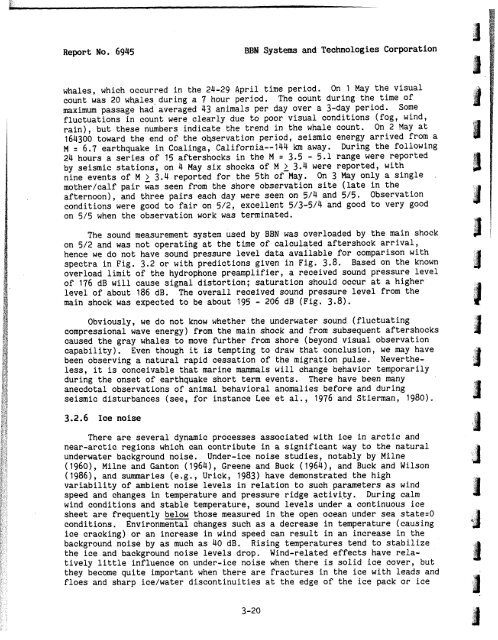Analysis and Ranking of the Acoustic Disturbance Potential of ...
Analysis and Ranking of the Acoustic Disturbance Potential of ...
Analysis and Ranking of the Acoustic Disturbance Potential of ...
Create successful ePaper yourself
Turn your PDF publications into a flip-book with our unique Google optimized e-Paper software.
Report No. 6945<br />
BBN Systems <strong>and</strong> Technologies Corporation<br />
whales, which occurred in <strong>the</strong> 24-29 April time period. On 1 May <strong>the</strong> visual<br />
count was 20 whalesoduring a 7 hour period. The count during <strong>the</strong> time <strong>of</strong><br />
maximum passage had averaged 43 animals per day over a 3-day period. Some<br />
fluctuations in count were clearly due to poor visual conditions (fog, wind,<br />
rain), but <strong>the</strong>se numbers indicate <strong>the</strong> trend in <strong>the</strong> whale count. On 2 May at<br />
164300 toward <strong>the</strong> end <strong>of</strong> <strong>the</strong> oQservation period, seismic energy arrived from a<br />
M = 6.7 earthquake in Coalinga, California--144 km away. During <strong>the</strong> following<br />
24 hours a series <strong>of</strong> 15<br />
,<br />
aftershocks in <strong>the</strong> M = 3.5 - 5.1 range were reported<br />
by seismic stations, on 4 May six shocks <strong>of</strong> M 3.4 were reported, with<br />
nine events <strong>of</strong> M 2 3.4 reported for <strong>the</strong> 5th <strong>of</strong> May. On 3 May only a single ,<br />
mo<strong>the</strong>r/calf pair was seen from <strong>the</strong> shore observation site (late in <strong>the</strong><br />
afternoon), <strong>and</strong> three pairs each day were seen on 5/4 <strong>and</strong> 5/5. Observation<br />
conditions were good to fair on 5/2, excellent 5/3-5/4 <strong>and</strong> good to very good<br />
on 5/5 when <strong>the</strong> observation work was terminated.<br />
The sound measurement system used by BBN was overloaded by <strong>the</strong> main shock<br />
on 5/2 <strong>and</strong> was not operating at <strong>the</strong> time <strong>of</strong> calculated aftershock arrival,<br />
hence we do not have sound pressure level data available for comparison with<br />
spectra in Fig. 3.2 or with predictions given in Fig. 3.8. Based on <strong>the</strong> known<br />
overload limit <strong>of</strong> <strong>the</strong> hydrophone preamplifier, a received sound pressure level<br />
<strong>of</strong> 176 dB will cause signal distortion; saturation should occur at a higher<br />
level <strong>of</strong> about 186 dB. The overall received sound pressure level from <strong>the</strong><br />
main shock was expected to be about 195 - 206 dB (Fig. 3.8) .<br />
Obviously, we do not know whe<strong>the</strong>r <strong>the</strong> underwater sound (fluctuating<br />
compressional wave energy) f~om <strong>the</strong> main shock <strong>and</strong> from subsequent aftershocks<br />
caused <strong>the</strong> gray whales to move fur<strong>the</strong>r from shore (beyond visual observation<br />
capability). Even though it is tempting to draw that conclusion, we may have<br />
been observing a natural rapid cessation <strong>of</strong> <strong>the</strong> migration pulse. Never<strong>the</strong>less,<br />
it is conceivable that marine mammals will change behavior temporarily<br />
during <strong>the</strong> onset <strong>of</strong> earthquake short term events. There have been many<br />
anecdotal observations <strong>of</strong> animal behavioral anomalies before <strong>and</strong> during<br />
seismic disturbances (see, for instance Lee et al., 1976 <strong>and</strong> Stierman, 1980).<br />
3.2.6 Ice noise<br />
There are several dynamic processes associated with ice in arctic <strong>and</strong><br />
near-arctic regions which can contribute in a significant way to <strong>the</strong> natural<br />
underwater background noise. Under-ice noise studies, notably by Milne<br />
(1960), Milne <strong>and</strong> Ganton (1964), Greene <strong>and</strong> Buck ( 1964), <strong>and</strong> Buck <strong>and</strong> Wilson<br />
(1986), <strong>and</strong> summaries (e.g., Urick, 1983) have demonstrated <strong>the</strong> high<br />
variability <strong>of</strong> ambient noise levels in relation to such parameters as wind<br />
speed <strong>and</strong> changes in temperature <strong>and</strong> pressure ridge activity. During calm<br />
wind conditions <strong>and</strong> stable temperature, sound levels under a continuous ice<br />
sheet are frequently below those measured in <strong>the</strong> open ocean under sea state=O<br />
conditions. Environmental changes such as a decrease in temperature (causing<br />
ice cracking) or an increase in wind speed can result in an increase in <strong>the</strong><br />
background noise by as much as 40 dB. Rising temperatures tend to stabilize<br />
<strong>the</strong> ice <strong>and</strong> background noise levels drop. Wind-related effects have relatively<br />
little influence on under-ice noise when <strong>the</strong>re is solid ice cover, but<br />
<strong>the</strong>y become quite important when <strong>the</strong>re are fractures in <strong>the</strong> ice with leads <strong>and</strong><br />
floes <strong>and</strong> sharp ice/water discontinuities at <strong>the</strong> edge <strong>of</strong> <strong>the</strong> ice pack or ice
















